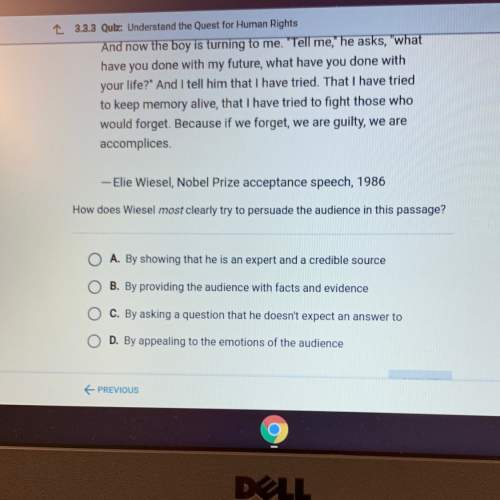excerpt from "four freedoms speech" by franklin d. roosevelt

English, 17.10.2019 05:50 c1100321311
Read the passage.
excerpt from "four freedoms speech" by franklin d. roosevelt
in the future days, which we seek to make secure, we look forward to a world founded upon four essential human freedoms.
the first is freedom of speech and expression—everywhere in the world.
the second is freedom of every person to worship god in his own way—everywhere in the world
the third is freedom from want—which, translated into world terms, means economic understandings which will secure to every nation a healthy peacetime life for its inhabitants—everywhere in the world.
the fourth is freedom from fear—which, translated into world terms, means a worldwide reduction of armaments to such a point and in such a thorough fashion that no nation will be in a position to commit an act of physical aggression against any neighbor—anywhere in the world.
that is no vision of a distant millennium. it is a definite basis for a kind of world attainable in our own time and generation. that kind of world is the very antithesis of the so-called new order of tyranny which the dictators seek to create with the crash of a bomb.
to that new order we oppose the greater conception—the moral order. a good society is able to face schemes of world domination and foreign revolutions alike without fear.
read the excerpt from franklin d. roosevelt's "four freedoms speech," and then consider the four-framed image.
link below, just click or copy and paste the url.
question
how does the printed text compare to the image?
while the text describes how each of the four freedoms relate to and depend upon each other, the image depicts them as separate and wholly independent.
while the text makes clear that roosevelt is focused only on ensuring that these freedoms exist in america, the image implies that each one should flourish across the globe.
while the text makes clear which of the four freedoms roosevelt considers to be most important, the image implies that all four freedoms are equally essential.
while the text describes each freedom in more general terms, the image provides specific and evocative visual representations of each freedom described.

Answers: 1


Another question on English

English, 22.06.2019 07:00
In the farewell speech, queen elizabeth's use of first-person point of view her to appear to be impartial and objective, prevents her from addressing the audience directly allows her to share her personal thoughts and ideas. makes it seem as though she's observing from the outside.
Answers: 3

English, 22.06.2019 07:30
M read the sentence.what best describes the underlined part of the sentence,and why? alma plans to visit london and paris, where her parentswent on their first trip together as a married couple.it is a restrictive relative clause because it begins with arelative pronoun, has both a subject and a verb, and is notnecessary to the meaning of the sentence.it is a nonrestrictive relative clause because it begins witha relative pronoun, has both a subject and a verb, and isnecessary to the meaning of the sentence.it is a restrictive relative clause because it begins with arelative pronoun, has both a subject and a verb, and isnecessary to the meaning of the sentence.it is a nonrestrictive relative clause because it begins witha relative pronoun, has both a subject and a verb, and isnot necessary to the meaning of the sentence.
Answers: 2

English, 22.06.2019 10:00
Ineed . read the passage, and choose the two (2) inferences that are most firmly based on the given information. up through the 1700s, many europeans believed that a king’s touch could cure diseases. at his coronation in 1775, for example, king louis the sixteenth of france touched 2,400 of his ailing subjects. 1. the touch of a king truly has special healing power others do not have 2. there had been other kings of france named louis. 3. french coronations were public events. 4. the french suffered
Answers: 1

English, 22.06.2019 10:00
“to build a fire” what is happening to the mans fingers and toes
Answers: 2
You know the right answer?
Read the passage.
excerpt from "four freedoms speech" by franklin d. roosevelt
excerpt from "four freedoms speech" by franklin d. roosevelt
Questions




English, 15.10.2019 11:00




Mathematics, 15.10.2019 11:00


English, 15.10.2019 11:00

Mathematics, 15.10.2019 11:00


Social Studies, 15.10.2019 11:00


Social Studies, 15.10.2019 11:00


Social Studies, 15.10.2019 11:00

Mathematics, 15.10.2019 11:00

Biology, 15.10.2019 11:00




